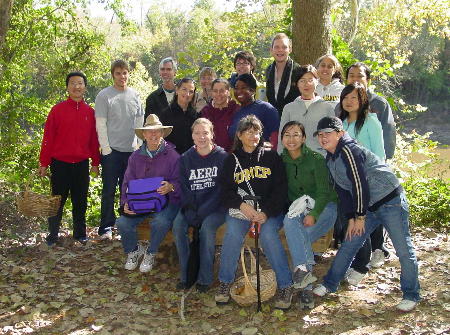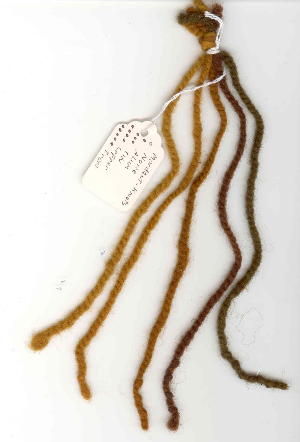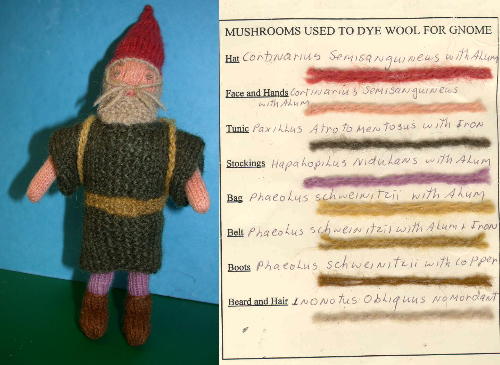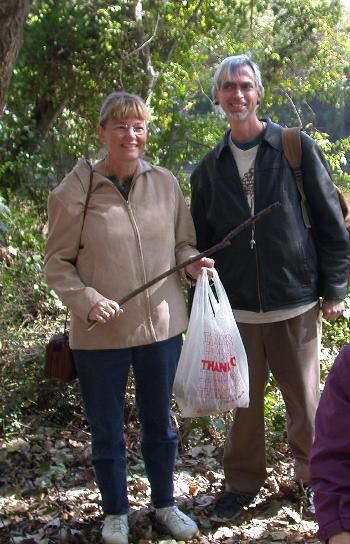Phaeolus schweinitzii, the dye polypore or velvet-top fungus
Tom Volk's Fungus of the Month for November 2007
by Tom Volk, Debby Hanmer, and her Mycology class from fall 2007 at the University of North Carolina Pembroke.
Please click
TomVolkFungi.net for the rest of Tom Volk's pages on fungi
In November 2007 the mycology class at University of North Carolina at Pembroke and the Cape Fear Valley Botanical Garden hosted a foray with me (!) as their special guest. The very first mushroom we found was a nice specimen of Phaeolus schweinitzii near the base of a loblolly pine tree.
Phaeolus schweinitzii is an annual conk stalked with circular sunken center. with a bracket shape. The upper surface is reddish brown with a light yellow margin and has a velvety texture when young. Thus the common name "velvet-top fungus."
Phaeolus schweinitzii produces annual basidiocarps from late summer into the fall, especially during wet weather. It is orange, red brown or yellow when young becoming rust or dark brown with age. It may be found in clusters, but the fruiting bodies are usually single.
Phaeolus schweinitzii yields about what colors you would expect. The yellow edges are used as a bright yellow dye. Darker parts make a rusty brown dye. It depends on what metals are used as mordants, which serve to stick the dye molecules to the wool fibers. In the wool strands to the left, my friend Susan Hopkins has used various mordants (L to R: no mordant, alum, tin, copper, iron) to yield different shades of color from the same mushroom, boiled in the same pot of dye.
One of my treasured mushroom possessions is the knitted gnome to the right, made by my friend Susan Hopkins of New Jersey. The gnome is made with wool dyed with various mushrooms. The bag, belt, and boots of the gnome are made with P. schweinitzii using different mordants. To give you some idea of the scale, he stands about six inches high (15 cm).
The genus name Phaeolus means dark or obscure, referring to its dark brown color when mature. The species was named in honor of American mycologist Lewis David von Schweinitz, thus the species epithet of schweinitizii, meaning "of Schweinitz." He is widely considered the first major American mycologist, born in Bethlehem, PA, although he got his ministerial and mycological training in Moravia before returning to North Carolina. You can read more about Schweinitz here.
We hope you enjoyed learning about this "obscure" fungus. It's an important forest pathogen as well as an interesting source of mushroom dyes.
Learn more about fungi! Go to Tom Volk's Fungi Home Page --TomVolkFungi.net Return to Tom Volk's Fungus of the month pages listing
 A mushroom foray is a great way to get out into the woods, meet new friends and see interesting new fungi. If you haven't been to one yet, be sure to watch for one in your area! See http://www.mykoweb.com/na_mycos.html for a list of North American mushroom clubs.
A mushroom foray is a great way to get out into the woods, meet new friends and see interesting new fungi. If you haven't been to one yet, be sure to watch for one in your area! See http://www.mykoweb.com/na_mycos.html for a list of North American mushroom clubs.
 Phaeolus schweinitzii is a pathogen of conifers. It is a wood decay fungus that causes a brown rot of the roots and butt (base) of the tree. In brown rot the fungus digests mostly cellulose and leaves the lignin behind. Because cellulose is part of the structure that holds adjacent plant cells together, the wood loses strength quickly and the tree may break. Fungal spores in the soil probably infect the tree near root tips and spread upward. The conks can be found on the base of conifers or on the ground growing up from the roots near the tree. The fungus can be spread from tree to tree by the production of abundant basidiospores, and the mycelium can also grow through the soil. Since we don't often see what can goes on underground, it might be surprising to find out that adjacent trees often share roots, which facilitates easy movement of the fungal mycelium between trees.
Phaeolus schweinitzii is a pathogen of conifers. It is a wood decay fungus that causes a brown rot of the roots and butt (base) of the tree. In brown rot the fungus digests mostly cellulose and leaves the lignin behind. Because cellulose is part of the structure that holds adjacent plant cells together, the wood loses strength quickly and the tree may break. Fungal spores in the soil probably infect the tree near root tips and spread upward. The conks can be found on the base of conifers or on the ground growing up from the roots near the tree. The fungus can be spread from tree to tree by the production of abundant basidiospores, and the mycelium can also grow through the soil. Since we don't often see what can goes on underground, it might be surprising to find out that adjacent trees often share roots, which facilitates easy movement of the fungal mycelium between trees.
 Phaeolus schweinitzii is not edible but can be used for making dyes. There is a very interesting "subculture" of people who are interested in mushrooms and other fungi mainly because they can dye wool with them. Dyeing wool with fungi (probably lichens) is even mentioned in the Bible (Ezekiel 27:7). It's very interesting to see what colors come out of different mushrooms. Many are not what you'd expect at all. Surprisingly many brightly colored mushrooms won't dye wool at all-- fungi like chanterelles, Laetiporus sulphureus, red Russula emetica , and bright colored Amanita species like Amanita muscaria have no dyeing ability at all. Some surprises come from dull brown colored fungi like Hapalopilus nidulans,which yield a beautiful lilac color. Some brightly colored fungi like Cortinarius semisanguineus and lobster mushrooms provide some beautiful colors. Another important point to remember is that we're talking about dyeing with mushrooms not dying from mushrooms...
Phaeolus schweinitzii is not edible but can be used for making dyes. There is a very interesting "subculture" of people who are interested in mushrooms and other fungi mainly because they can dye wool with them. Dyeing wool with fungi (probably lichens) is even mentioned in the Bible (Ezekiel 27:7). It's very interesting to see what colors come out of different mushrooms. Many are not what you'd expect at all. Surprisingly many brightly colored mushrooms won't dye wool at all-- fungi like chanterelles, Laetiporus sulphureus, red Russula emetica , and bright colored Amanita species like Amanita muscaria have no dyeing ability at all. Some surprises come from dull brown colored fungi like Hapalopilus nidulans,which yield a beautiful lilac color. Some brightly colored fungi like Cortinarius semisanguineus and lobster mushrooms provide some beautiful colors. Another important point to remember is that we're talking about dyeing with mushrooms not dying from mushrooms...
 In the US the Native Americans were utilizing mushroom dyes and P. schweinitzii was mentioned creating yellow, brown and green colors. In 1970 Miriam C. Rice started a modern renaissance of the dyeing tradition when she collected P. schweinitzii for her Mendocino Art Center where she was teaching classes in dyeing of yarns and paper. She also authored two books, "Let's Try Mushrooms for color" and "Fungi and Fibers." Mushroom dyeing conventions are now held throughout the world.
In the US the Native Americans were utilizing mushroom dyes and P. schweinitzii was mentioned creating yellow, brown and green colors. In 1970 Miriam C. Rice started a modern renaissance of the dyeing tradition when she collected P. schweinitzii for her Mendocino Art Center where she was teaching classes in dyeing of yarns and paper. She also authored two books, "Let's Try Mushrooms for color" and "Fungi and Fibers." Mushroom dyeing conventions are now held throughout the world.
 This month's coauthor is my good friend Debby Hanmer, who used to teach with me at UW-La Crosse. She is now at the University of North Carolina Pembroke in the Biology Department, where she teaches courses in Botany, Mycology and Plant Physiology.
This month's coauthor is my good friend Debby Hanmer, who used to teach with me at UW-La Crosse. She is now at the University of North Carolina Pembroke in the Biology Department, where she teaches courses in Botany, Mycology and Plant Physiology.
If you have anything to add, or if you have corrections, comments, or recommendations for future FotM's (or maybe you'd like to be co-author of a FotM?), please write to me at
This page and other pages are © Copyright 2008 by Thomas J.
Volk, University of Wisconsin-La Crosse.

